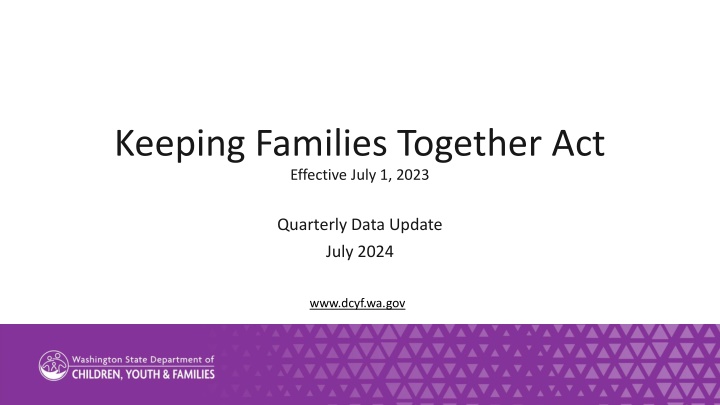
Impact of Keeping Families Together Act and Long-Term Trends in Child Welfare
Explore the effectiveness of the Keeping Families Together Act in Washington, highlighting reduced removals and trends in child welfare outcomes. Learn about the decrease in entries into care and increased participation in Family Voluntary Services, addressing challenges like opioid crises and care placements.
Download Presentation

Please find below an Image/Link to download the presentation.
The content on the website is provided AS IS for your information and personal use only. It may not be sold, licensed, or shared on other websites without obtaining consent from the author. If you encounter any issues during the download, it is possible that the publisher has removed the file from their server.
You are allowed to download the files provided on this website for personal or commercial use, subject to the condition that they are used lawfully. All files are the property of their respective owners.
The content on the website is provided AS IS for your information and personal use only. It may not be sold, licensed, or shared on other websites without obtaining consent from the author.
E N D
Presentation Transcript
Keeping Families Together Act Effective July 1, 2023 Quarterly Data Update July 2024 www.dcyf.wa.gov www.dcyf.wa.gov 1
What were seeing: The law is meeting the intended impact of reducing removals We are not removing many children at high risk, and those children are with their families and communities. Internal reviews of Safe Child Consultations indicate that we are taking additional steps to prevent removal of a child and to support a safety plan for the family The overlap between 1227 and Plan of Safe Care is reducing screened in intakes involving substance-exposed newborns Fentanyl crisis leaves many children at risk A lack of SUD treatment services and other community-based supports for families places children at further risk 2
Long-term trends: Between state fiscal year (SFY) 2018 and the implementation of HB1227 at the end of SFY2023, Washington saw a 35.6% decrease in the number of children in out of home care (point in time). This trend is largely consistent with the national trends on children in out of home care. Since 2020, DCYF has seen an increasing percentage of moderately high to high-risk cases being re-referred to CPS intake and screening- in (within 90 days of the completion of the risk assessment.) Since 2019, opioid-related emergencies have dramatically increased for the entire population (both adults and children) in Washington. 3
Entries into care have decreased by 14.2% since the new law went into effect SFY2023 compared to SFY2024 Count and Percentage Change in Children Entering Care by Original Region, July 1- June 30 20% Statewide: 14.2% reduction in children entering care Largest reductions remain in Clark, Spokane, and Yakima Counties 35 7.6% 10% 0% -3 -20 -4.6% -0.7% -10% -122 -16.1% -20% -172 -24.8% -30% -40% -180 -38.3% -50% Region 1 Region 2 Region 3 Region 4 Region 5 Region 6 12024 estimate adjusted for known data lag, observed 2024 count=2,800 DCYF OIAA (July 2024). CW Reporting Portal, 4 Out of Home Exits and Entries [July 2022-June 2024].
Entries into care are down across all categories, while participation in Family Voluntary Services has increased by 10% All entries into care July 1, 2022- June 30, 2023 July 1, 2023-June 30, 2024* Voluntary Placements 544 497 Protective Custodies 1,652 1,565 Court Approved Placements 1,108 709 *2023/24 data are observed, not adjusted for known data lag, so may increase somewhat as more case data are entered into FamLink Cases receiving services Family Voluntary Services 1,809 1,994 ** Family Voluntary Services identifies the distinct count of families served by FVS during the time frame identified DCYF OIAA (July 2024). CW Reporting Portal, Out of Home Exits and Entries and CW Assignment Report [July 2022-June 2024] 5
The largest reductions in out of home placements are among infants Total Fewer Children Entering Care by Age Group July 1, 2022 June 30, 2023, compared to July 1, 2023 June 30, 2024 Number Percentage Age 0-1 -229 -20.8% Age 2-3 -30 -7.5% Age 4-11 -104 -9.4% Age 12-17 -126 -18.4% Observed, not adjusted for data lag DCYF OIAA (July 2024), CW Reporting Portal, Out of Home Exits and Entries [July 2022-June 2024] 6
70 65 60 50 51 43 40 34 33 30 35 29 28 23 20 20 10 7 4 3 0 2019 2020 2021 2022 2023 2024 Critical Incidents Critical Incidents- Projected Fentanyl/opioid related Fentanyl/opioid related - projected *As of July 2024, there have been 18 critical incidences that have been identified as fentanyl/opioid related 7 DCYF PPS (July 2024), Administrative Incident Reporting and Fatality Reviews [Jan 2019-2024]
